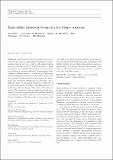| dc.contributor.author | Raviv, Dan | |
| dc.contributor.author | Bronstein, Alexander M. | |
| dc.contributor.author | Bronstein, Michael M. | |
| dc.contributor.author | Waisman, Dan | |
| dc.contributor.author | Sochen, Nir | |
| dc.contributor.author | Kimmel, Ron | |
| dc.date.accessioned | 2016-07-14T20:10:08Z | |
| dc.date.available | 2016-07-14T20:10:08Z | |
| dc.date.issued | 2013-10 | |
| dc.identifier.issn | 0924-9907 | |
| dc.identifier.issn | 1573-7683 | |
| dc.identifier.uri | http://hdl.handle.net/1721.1/103615 | |
| dc.description.abstract | Traditional models of bendable surfaces are based on the exact or approximate invariance to deformations that do not tear or stretch the shape, leaving intact an intrinsic geometry associated with it. These geometries are typically defined using either the shortest path length (geodesic distance), or properties of heat diffusion (diffusion distance) on the surface. Both measures are implicitly derived from the metric induced by the ambient Euclidean space. In this paper, we depart from this restrictive assumption by observing that a different choice of the metric results in a richer set of geometric invariants. We apply equi-affine geometry for analyzing arbitrary shapes with positive Gaussian curvature. The potential of the proposed framework is explored in a range of applications such as shape matching and retrieval, symmetry detection, and computation of Voroni tessellation. We show that in some shape analysis tasks, equi-affine-invariant intrinsic geometries often outperform their Euclidean-based counterparts. We further explore the potential of this metric in facial anthropometry of newborns. We show that intrinsic properties of this homogeneous group are better captured using the equi-affine metric. | en_US |
| dc.description.sponsorship | Seventh Framework Programme (European Commission) (grant agreement no. 267414) | en_US |
| dc.publisher | Springer US | en_US |
| dc.relation.isversionof | http://dx.doi.org/10.1007/s10851-013-0467-y | en_US |
| dc.rights | Article is made available in accordance with the publisher's policy and may be subject to US copyright law. Please refer to the publisher's site for terms of use. | en_US |
| dc.source | Springer US | en_US |
| dc.title | Equi-affine Invariant Geometry for Shape Analysis | en_US |
| dc.type | Article | en_US |
| dc.identifier.citation | Raviv, Dan, Alexander M. Bronstein, Michael M. Bronstein, Dan Waisman, Nir Sochen, and Ron Kimmel. “Equi-Affine Invariant Geometry for Shape Analysis.” J Math Imaging Vis 50, no. 1–2 (October 2, 2013): 144–163. | en_US |
| dc.contributor.department | Massachusetts Institute of Technology. Media Laboratory | en_US |
| dc.contributor.mitauthor | Raviv, Dan | en_US |
| dc.relation.journal | Journal of Mathematical Imaging and Vision | en_US |
| dc.eprint.version | Author's final manuscript | en_US |
| dc.type.uri | http://purl.org/eprint/type/JournalArticle | en_US |
| eprint.status | http://purl.org/eprint/status/PeerReviewed | en_US |
| dc.date.updated | 2016-05-23T12:15:48Z | |
| dc.language.rfc3066 | en | |
| dc.rights.holder | Springer Science+Business Media New York | |
| dspace.orderedauthors | Raviv, Dan; Bronstein, Alexander M.; Bronstein, Michael M.; Waisman, Dan; Sochen, Nir; Kimmel, Ron | en_US |
| dspace.embargo.terms | N | en |
| dc.identifier.orcid | https://orcid.org/0000-0003-3254-2050 | |
| mit.license | PUBLISHER_POLICY | en_US |
